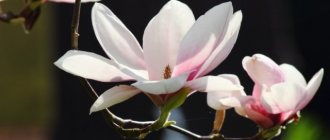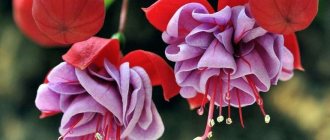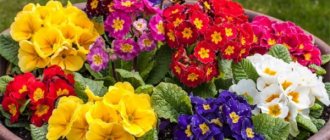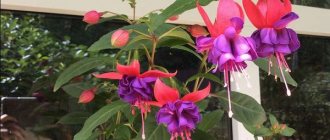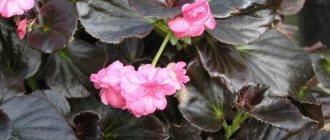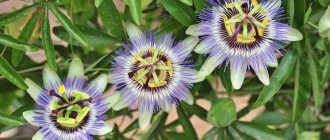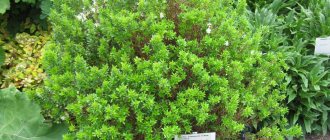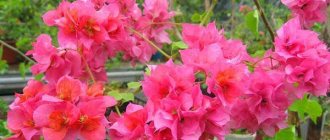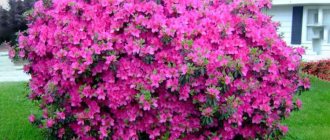The beauty of Bougainvillea is not lost and amazes the imagination even against the backdrop of the lush splendor of the flora of the southern countries. It looks harmonious both in wildlife and in landscape design. Unfortunately, Bougainvillea is a plant that requires certain weather conditions to grow and care for in open ground. It can be cultivated outdoors and in the garden all year round only in regions with a warm climate.
Climatic conditions for growing Bougainvillea outdoors
Growing Bougainvillea garden in open ground is possible only in countries with a warm tropical climate. It does not tolerate cold and even when the air temperature drops below +5 °C it begins to get sick, and at 0 °C it can die. In Russia, climatic conditions suitable for this exotic are found only in Crimea in the southernmost regions of the peninsula. In other regions of our country, pot cultivation of heat-loving exotics is used and taken outside during the warm season.
With this method of care and maintenance, plants growing in a house or greenhouse in tubs or large pots are wintered indoors or in protected ground with a controlled climate. In late spring or early summer, when the threat of frost has passed, they are moved to fresh air and left in the garden as long as the weather is warm. Sometimes the tubs are buried, creating the illusion that the potted tree or shrub is growing directly from the ground. For example, Bougainvillea is cultivated in the Moscow region, in the southern Urals and some other regions of our country.
When taking a plant outside, you need to install the tub once; you cannot even turn it, changing the direction of the branches. Otherwise, the Bougainvillea will stop blooming and shed its leaves.
General idea of bougainvillea culture
A climbing vine from the family. Nociformes, widespread in South America, have also attracted interest from floriculture lovers in Russia. In the natural environment it can be represented by different life forms: liana, shrub or small tree. More often it is a shrub with clinging shoots. Due to the thorns on the stem, bougainvillea holds onto its support.
The shoots grow very quickly, capable of stretching up to 5 m. The leaf blade is oval, the ends of the leaves are pointed. During the flowering period (from May to November), they are hidden under a screen of bright stipules. Bougainvillea is grown as a large container plant for a winter garden, greenhouse or indoor conditions. In culture, the two most famous species are Bougainvillea glabra (naked) and Bougainvillea spectabilis (wonderful).
The flowers are inconspicuous and inconspicuous; the decorative appearance of the plant is provided by bracts (bacteria), which have a wide variety of colors. There are two-color varieties, as well as varieties that can change color during flowering. The variegated leaves also add decorativeness to the vine. Breeders dream of breeding bougainvillea without thorns and with blue stipules, but so far this is just a dream. Although the few modern varieties in cultivation are amazing.
Choosing a place and landing
In order for Bougainvillea to develop well and bloom profusely on the street or in the garden, it needs to be provided with conditions as close as possible to its usual habitat. Under natural conditions, the heat-loving beauty usually grows on sunny rocky slopes. Therefore, when choosing a location for it, the following factors should be taken into account:
- the planting area should be well lit, protected from the wind, and free from other trees and shrubs;
- the soil on the site should be well aerated, drained, dense, neutral or slightly alkaline.
If garden soil for Bougainvillea does not meet these criteria, you can buy it in a specialized store or mix it yourself, from equal proportions of peat, turf soil, sand and humus.
Bougainvillea is planted in open ground in the spring, when stable warm weather is established outside, by cuttings or bushes, in pre-prepared holes. Before planting a plant, you need to make sure that their depth is sufficient so that a drainage layer can be laid on the bottom. Soil mixed with humus is poured onto the drainage and a seedling is placed. The soil around it needs to be lightly compacted and then watered abundantly.
Types and varieties
The plant belongs to the Noctiflower family, a not very large family that includes about 15 species. Only some of them can be cultivated indoors or in the middle zone in open ground. These are shrubs with long vine-like shoots; the plant is very plastic and forms a well-shaped trunk.
Beautiful or wonderful (Bougainvillea spectabilis) is a large plant, in nature it grows up to 15 m. The leaves are velvety.
Naked (Bougainvillea glabra) - very popular as a houseplant because it is compact (no higher than 5 m) and forms well. The ancestor of many modern varieties. The leaves are smooth.
Peruvian (Bougainvillea Peruviana) is not the most popular species in gardening. However, it is gradually gaining ground and is famous for its ability to bloom frequently (several artificial “winterings” can be organized in a year). Reluctant to bush, requires regular pruning.
Bougainvillea x buttiana is a hybrid of naked and Peruvian.
It is hardly possible to cover the entire diversity of modern varieties within even a few articles. Therefore, we present the most modern and interesting hybrid forms:
Variety 'Bambino Majik'
Variegated hybrid variety 'Orange Ice'
Compact multi-tonal variety Thai Delight.
Form with double flowers.
Features of caring for Bougainvillea in the garden
Bougainvillea is an exotic beauty, growing and caring for it in the open ground is quite a troublesome task. But if climatic conditions allow and the basic rules of its maintenance are followed, it will delight with bright, abundant flowering 9 months a year in seasonal cycles of 4 to 6 weeks.
In the first 2-3 years in open ground, Bougainvillea actively grows and accumulates green mass, but does not bloom. It reaches its maximum decorativeness at the age of 4-5 years.
Temperature
Bougainvillea loves warmth. Even in the favorable California climate, when grown outside, there is still a risk of freezing. Therefore, those who are planning to grow a southern beauty should take into account what the temperature necessary for its harmonious development should be. Its parameters are as follows:
- in summer, during flowering - +21-27 °C;
- in spring at the beginning of the growing season - above + 10 °C;
- The minimum temperature of the earth's coma is +5 °C.
If in winter the plants placed outside in pots and tubs for the summer are kept in warm conditions, the dormant period will not occur, but in the summer their flowering will be weak.
Watering
Water for irrigation is taken warm and settled. An important condition is maintaining water balance. It is recommended to water abundantly, but not excessively: the soil should not become waterlogged, but drying out of the top layer is also undesirable.
In summer, Bougainvillea is watered 2 times a week, in the morning. With the arrival of autumn and until the next flowering, the frequency of watering is reduced, making sure that the soil around the trunk does not become too dry. If the plant has lost its leaves, watering must be stopped completely.
In hot, dry weather, green leaves are sprayed with warm water, while care must be taken to ensure that the bracts remain dry. During prolonged rainfall, in order to prevent rotting of the root system, it is better to protect the bush from excess moisture.
Top dressing
From April to September, Bougainvillea has a period of active growth, and during this time the plant needs to be fed. Every spring it is recommended to add humus under the bushes. In addition, for young seedlings, once every two weeks it is recommended to apply a complex of mineral or special fertilizers for flowering plants. They are scattered around the bush, and then the ground is loosened.
Starting from the second year, fertilizing is applied once every two months. In this case, preference should be given to those that contain potassium, iron and phosphorus. But you should be careful with nitrogen fertilizers; they can provoke an increase in green mass to the detriment of flowers and bracts.
Nitrogen fertilizers include: ammonium nitrate, ammonium sulfate, potassium nitrate, urea, sodium nitrate, calcium nitrate.
Crown trimming
Pruning young and skeletal branches allows you to form a beautiful crown and promotes lush and abundant flowering. If this is not carried out, the number of young shoots decreases, and as a result, the decorativeness of the plant as a whole decreases. Bougainvillea pruning in open ground is carried out in 3 stages:
- in the fall, before the start of the dormant period, the branches that have grown over the summer are shortened by half;
- in the spring, before the start of the growing season, bushiness is caused: lignified branches are cut to 10-13 cm;
- During the growing season, a crown is formed: branches that violate the intended composition and weak growth are removed.
When pruning, be sure to leave 5-7 cm of the current year's shoot. Dormant buds on old shoots are very difficult to awaken, and new shoots may not form.
Proper pruning of Bougainvillea consists of the following steps:
- Step 1. Prepare the necessary tools and materials: gardening gloves, pruning shears, disinfectant (bleach or medical alcohol).
- Step 2. To prevent the plant from becoming infected with diseases, wipe the pruning shears with a disinfectant.
- Step 3: Begin pruning by removing diseased, damaged or dead branches.
- Step 4. Before you start pruning healthy parts, re-disinfect the pruning shears with bleach or alcohol.
- Step 5. Remove branches that you think are unnecessary and those that were damaged during the pruning process.
- Step 6: Step back a few steps, carefully inspect the plant, and continue pruning until you achieve the desired shape.
- Step 7. Remove all cut branches from the area.
- Step 8. To encourage fruit set, repeat pruning throughout the growing season every 4-6 weeks or as needed.
- Step 9. Between regular prunings, pinch - manually tear off the wilted tops of the inflorescences.
- Step 10. After trimming a large number of branches, feed the Bougainvillea with complex fertilizer.
Advice from experienced gardeners:
- To prevent flowering from becoming less abundant or stopping altogether, do not prune your Bougainvillea too low.
- Remember to regularly remove wilted flowers. Remaining on the bush, they delay the formation of new buds.
- When working with bougainvillea garden, do not forget to wear work gloves. Thick branches and sharp thorns can hurt your hands.
As you master pruning Bougainvillea, keep in mind that pinching can be done at any time of the year and as often as you want. The more often you prune faded blossoms, the more new flowers will form on the plant.
You can choose the shape of the crown at your discretion: leave it to grow as a vine, form it into a bush, or graft it onto a standard.
Liana-shaped crown
To support the vine and make it aesthetically pleasing, it is necessary to select a suitable support. You can shoot shoots along the walls of a gazebo or house, purchase a suitable support in a specialized store, or make it yourself, for example, from wire, willow twigs, or bamboo stems. The shape of the support can also be varied: arch, lattice, wigwam.
Bush formation
To form a bush of a certain shape, a wire fence is installed around it. Young shoots are directed along the fence and are fixed to it as they develop. After the base of the form has been formed and the shoot has outgrown the fence by a few centimeters, pruning is carried out. Only the upper, young, green shoots are subject to formation. Lignified branches need to be cut off completely, as they are not suitable for crown formation.
Formation of a standard form
This method of cultivation may take several years. The first step is to determine the future height of the trunk and the desired crown diameter. A support corresponding to these dimensions is placed next to the plant. The cutting is carefully pulled to it and fixed. As soon as the cutting outgrows the support by a couple of centimeters, you need to pinch the growth point and then remove all the shoots from the standard stem. You can leave only a few upper branches, which will be the basis of the future crown. Pruning is carried out only for young shoots. When the crown is finally formed, remove all shoots that violate its boundaries. Over time, the trunk will become more powerful and will begin to resemble a tree trunk.
Pruning and bonsai
Bougainvillea is a popular plant for bonsai, it allows you to get any shape of a bush and gratefully responds to pruning with lush flowering. Trimming to stimulate flowering is also recommended for large plants. Bougainvillea itself does not form a crown; it has long shoots, and from a distance the plant without formation resembles a hanging one.
Types of pruning:
- Before the period of winter dormancy , in the fall the branches are shortened by half.
- Spring pruning : remove 10-13 cm for better tillering.
- Periodic : as necessary, weak shoots or shoots that interfere with the crown are cut out in the summer. Also, faded shoots are regularly shortened, leaving shoots of 4-6 buds - this way you can stimulate repeat flowering in the same season.
Summer pruning.
Young shoots are pruned, no older than 3-4 years; lignified ones should not be touched - this makes no sense, new buds on such branches almost never awaken. Although lignified shoots are successfully pruned when forming a bonsai.
Shapes that can be created from bougainvillea:
- Ampelnaya.
- Bush.
- Standard
- Bonsai.
Of these, the most complex are standard and bonsai - their formation will take several years. The ampelous form is relatively simple, the plant is planted in a suitable container, hanging shoots are trimmed as necessary. Bougainvillea is also often guided along supports for hanging plants, while maintaining a long central trunk.
In the photo there is a bare Bougainvillea bonsai - Bougainvillea glabra
Reproduction of garden Bougainvillea
Bougainvillea garden is propagated in three ways: layering, cuttings and seeds. Moreover, the most effective of them are the first two.
By layering
When propagating using layering, a young, low-lying shoot is selected. You need to make circular notches on it, bend it low to the ground and fix it in this position. With this method, regular and abundant watering of both the mother bush and the cuttings is recommended. You can separate the new plant from the mother plant immediately after rooting or next spring.
Cuttings
Cuttings from Bougainvillea garden are cut in late spring or early summer. You can take those that remain after formative pruning, but they must be lignified. The cut is made under the kidney. The shoots are cut into several pieces of 10-15 cm with 3-4 leaves, placed in settled water at room temperature for several hours, and then treated with a growth stimulator. After processing, the leaves, which should be located at the bottom of each cutting, are cut off. Each cutting is placed in a substrate of peat and sand, sunk into the ground up to the second internode, watered and covered with a jar or a mini-greenhouse is built. The room temperature must be maintained at 25 °C. Watering is no longer carried out, but the cuttings are ventilated and sprayed with water daily. A month later, when the roots have grown, it is planted in a permanent place.
Seeds
This is the most labor-intensive and time-consuming method. The seeds are found in pods inside dried bracts. They can only be collected from large, well-rooted plants. To obtain seedlings, seeds are sown in moist soil poured into a container from garden soil, peat and sand in a ratio of 2:1:1. A mini-greenhouse is best suited for germination. If it is not there, the soil is covered with film. From time to time, the substrate with seeds is slightly moistened. After the shoots appear and before they are picked, the film is opened for ventilation.
Creating man-made beauty with bougainvillea
An individual specimen of a tropical flower can last from one to 10 years under cultivated conditions. Bougainvillea reaches its maximum decorative value at the age of 4-5 years. The bushes planted in the soil of the greenhouse on the south side are especially beautiful. In summer they turn into flower avalanches. Compositions that include different colors are especially beautiful.
There is another way to use the effect of a single bush with different flowers. Initially, several plants are planted in one tub, an intertwined trunk of several vines and a lush multi-colored bush are formed by pruning bougainvilleas.
Unusual and fascinating with mystery, bonsai from naked bougainvillea. This variety lends itself perfectly to the formation of a standard. Arches made of vines, pergolas, gazebos, whatever the skillful hands of an artist can make from living material!
Caring for bougainvillea outdoors in winter
As already mentioned, growing Bougainvillea in open ground is possible only in areas where the temperature of the earthen coma enveloping its roots does not fall below + 5 °C. In Russia, these are the southernmost regions of the Crimean peninsula. But even here there is no guarantee that Bougainvillea will not freeze in winter. Therefore, for the winter (in the coldest months), it is advisable to cover it with special material and cover the ground around the trunk with spruce branches.
With tub crops grown in colder regions, for example Bougainvillea in the Moscow region, everything is simple - so that the heat-loving beauty does not freeze, the tub or pot with it needs to be moved to a house or greenhouse at the end of August or early September.
Otherwise, caring for Bougainvillea in winter is not too difficult. Before the onset of cold weather, it is recommended to shorten the shoots by half. Watering in winter is not interrupted, but is carried out much less frequently than in summer, just so that the earthen ball does not dry out.
Problems during cultivation
The plant is losing leaves
The most common problem is the falling of leaves or bright bracts (which, we repeat, are often mistaken for flowers, but are still closer in nature to leaves). Causes:
- Change of place, relocation of a flower from the fresh air (store, nursery) to an apartment.
- Change in room temperature.
- Change in humidity in the room.
If points 2 and 3 have changed, but within the normal limits for bougainvillea, then it acclimatizes quite quickly, however, this does not always happen, and here again an analysis of the reasons is necessary. Look what exactly has changed:
- It has become drier or the air temperature has risen, but watering remains the same - the plant lacks moisture.
- It has become more humid, but the watering has not changed - there is a risk of flooding the plant.
It is not difficult to distinguish a flooded plant from a drying one; the leaves of the former turn yellow and wither, falling off as if reluctantly; if the plant does not have enough watering, the leaves dry out, including those at the petiole, and fall off easily. If the green leaves fall off, then the bougainvillea does not have enough nutrition and needs feeding.
Plants placed on an open balcony or loggia in the summer are especially at risk. In the middle zone, the difference in daily temperatures may be too large.
Another negative factor is contrasting air flows . The plant loves even, soft warmth without changes. A draft or a flow of dry air from heating vents is a common cause of leaf loss and the formation of defective leaves and bracts.
Pests are another possible cause of leaf drop. It is not always possible to detect them immediately, but a careful examination will allow you to make an unambiguous diagnosis.
Bougainvillea can be affected by:
- In the rooms there is a spider key.
- In open ground: scale insects, aphids, whiteflies.
Variety "Scarlet O'Hara", formed by a trunk.
Why doesn't the plant bloom?
This is the second most common problem - bougainvillea grows well, but does not bloom, or the flowering is too poor .
Causes:
- The plant is fattening. Bougainvillea is one of those plants that requires a tight container for lush flowering, otherwise it begins to go “into the tops.”
- Cool and damp during summer maintenance. For example, if the bougainvillea is standing outside and is constantly “attacked” by rain, and the summer turns out to be cool.
- Lack of a rest period, or an incorrectly organized rest period . The temperature for setting buds should not exceed 10–12 °C, otherwise you should not expect abundant flowers. Sometimes a simple technique can stimulate the flowering of bougainvillea - artificial rest for 2-4 weeks. For this period, watering is limited (watered only after the top layer of soil has dried) and fertilizing is completely eliminated. As soon as young shoots with new buds are formed, the “diet” is stopped.
Where to place bougainvillea?
In order for a tree-like vine to have a strong trunk, a lush crown and delight with bright flowering, the most important thing is to choose the right place for it. Like a true beauty, she loves bright light, surrounded by which she seems even more charming.
In the summer, bungevillea feels great on balconies, terraces, and in the courtyard among flower beds in a sunny meadow.
In winter, she simply needs warmth and light, so it is best to place the flower on the windowsill or next to it in a room whose windows face south. Being a southern plant that came to us from Colombia, the tree-like vine does not like even slight coolness and drafts and reacts sharply to these phenomena by shedding its leaves. She also does not like it when her location is changed. If you frequently move a flower from place to place, it may stop developing and “freeze” for several months.
Also, the flower does not like it when its shoots try to wrap around the support.



